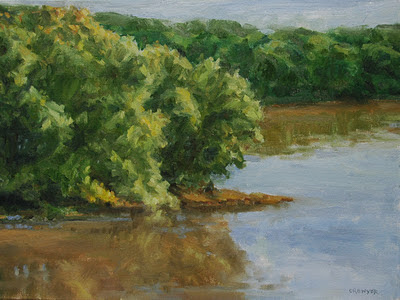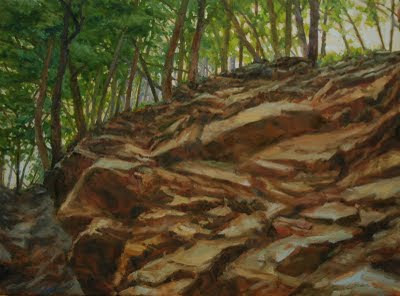Talisman
oil on gessoed watercolor paper 12" x 16"
krackle 1
oil on canvas 12" x 14"
I have a wonderful book on Degas that has really good reproductions of his work, including many drawings and studies one seldom sees in museum displays. The best part of this book, however captivating the work is, are the many letters of his and published remembrances of him by others that knew him at all periods of his life but especially in his advanced years. One of those remembrances concerns a time when Degas and a friend "slipped in to a private exhibit that his idol, Ingres, was holding in his studio for potential buyers and others of note in Parisian society. I think probably Degas use of 'slipped in' meant he and his companion crashed the party - but he worshipped Ingres and his work so I'm sure Degas felt it was justified.
Degas describes the people at the party as remarking on each work Ingres had hung for exhibit - enthusing over how 'the master' had evoked past styles and examples. Degas describes Ingres as quietly and with some discomfort accepting the accolades as if he was tolerating a misreading for the sake of not upsetting his public. Finally someone exclaimed once again that a particular work had explored another style - Ingres simply stated, 'I have many brushes'. Degas was said to have laughed and repeated this statement many times, thoroughly enjoying the clever remark.
What was Degas enjoying - what was Ingres getting at in his cryptic remark? I think it was a simple statement about not considering styles or end results (the things these collectors and society types were all about) - instead Ingres simply wished to follow his brushes into the exploration of the 'motif'. Tempered by the discipline of craft and technique acquired in a lifetime of immersion in line, form, shadow, and light - as well as a dedication to learning all he could from the masters who had gone before -what Ingres (and Degas after him) was after in any given work was the record of the complex process of reacting to the chosen subject. After all, it was Degas who replied to an elderly matron who asked him if he had lost his mind - "what good is my mind? I have my model, my pencils, my paper, my paints - what do I need with my mind?".
So here I'm offering two different works - a cliff of rocks from a few years back and a more recent abstraction. They are as different as two works by the same hand might be and yet, are inextricably related by mark, color, space, surface - in fact by spirit. The rock formations and deep forests that have been my most recent obsession can be seen in these two works that have gone before - some observers have the idea that if a painter works in different styles or types, they must be a dilettante - master of none. All I can reply to such nonsense is, 'I have many brushes' - so I am not caught-up in those concerns.

















































